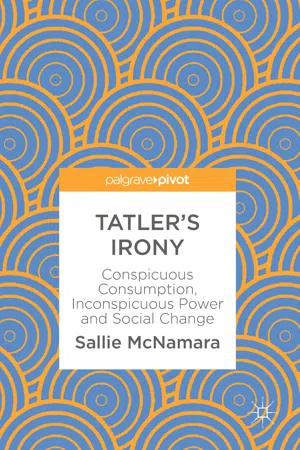The focus of this discussion is Tatler magazine, a monthly glossy aimed at the wealthiest/aspirational groups in British society, to explore how it addresses social change. The period being discussed is from 1997, the year New Labour were elected under Tony Blair , to 2010 when the Conservative party , and David Cameron , came into power. It started with a buoyant economy, which continued for much of the new millennium , until the financial crash in the summer of 2007. This crisis of neoliberalism , argued to be the “fourth crisis in capitalism since the late nineteenth century”, 1 and the effects of this “boom to bust” economy were widespread. For wealthy elites, London’s role as a major financial centre created a battle for resources, and it will be argued that features in the magazine express some anxieties regarding these new, i.e. foreign, arrivals. During the early years of the new millennium (the “noughties”), while there are concerns about “new money” there is also a sense of optimism, with discussion of wealth and power, of “bling bling ” and with lavish spectacle as the norm. However, the study will argue there are still some social groups which cause anxiety: wealth alone does not ensure approval and inclusion in the magazine. The use of humour, including tongue-in-cheek , satire , irony , is a major part of the magazine’s identity , and its use, which carries the potential for misinterpretation , will be explored. The main question being addressed is: how does Tatler negotiate the changing social, political, economic, and cultural climate and its potentially changing readership ?
The discussion will be placed in the context of social change, with the main themes being addressed outlined in each chapter. The approach is interdisciplinary, using a broad frame of reference within cultural studies to develop the textual/cultural analysis. Attention will be given to the discourse(s) employed in the magazine. The main approach, however, will be to consider class and social distinction as discussed by Beverley Skeggs, 2 to explore the symbolic boundaries created in the construction of new identities. Clearly magazines are varied in content, and this examination covers a fourteen-year period; the focus, therefore, will be on features that directly address those issues relevant to the discussion. This Introduction will outline Tatler ’s history , provide academic and historical context, and individual chapter content.
Tatler’s History
The origins of the magazine are in one of two papers, The Tatler and The Spectator , first published by Richard Steele and Joseph Addison , The Tatler between 1709 and 1711, The Spectator from 1711 to 1714. Steele and Addison adopted the fictional personae of Isaac Bickerstaff for The Tatler, published three times a week, their audience the rising bourgeoisie , the largely urban group in mid-level and social positions, now referred to as “middle class”. 3 Tatler included gossip overheard in the coffee houses frequented by Steele, along with stories made up by him. Despite this eavesdropping and voyeuristic attitude, Steele and Addison considered they had a clear moral dimension to their approach, as the aim was to comment on what they saw as excesses in their contemporary society, stating in the dedication to the first edition: “The general purpose of this Paper is to expose the false arts of life, to pull off the disguises of cunning, vanity and affectation, and to recommend a general simplicity in our dress, our discourse , and our behaviour”. 4 This dedication was to a Mr. Arthur Maynwaring , who as well as being the primary organizer, writer and reviser of Whig propaganda, was the principal political advisor to the Duchess of Marlborough , an active figure in Whig politics . 5 Despite the magazine’s general popularity, Steele’s Whig anti-Tory politics were viewed with disfavour and it was closed down by the government after twenty months.
Tatler subsequently had an uneven, and somewhat chequered career: a facsimile was published over a century later in 1877, its popularity was such that it sold out and was reprinted a second time. The magazine was resurrected at least five times in the eighteenth and nineteenth centuries, though apparently with little success. 6 In 1901, it was bought by journalist and literary critic Clement King Shorter , who, aided by technological developments such as processes of newspaper printing and photography, launched it as a pictorial society magazine. The contents were not dissimilar to those of today as it commented on social trends, the social calendar, popular country sporting activities, and, using Shorter’s phrase, “global celebrities”. 7 The magazine was sold following Shorter’s death in 1926, and went on to have various owners , including the family-run Ingram group until 1961, the Thompson Organization , then owners of The Sunday Times, who renamed it London Life, until 1965. From 1968, what followed was what Tatler describes as a “disastrous ten-year period” when, title restored under the ownership of Guy Wayte , circulation fell to about 3000 copies per month. 8 Its fortunes were revived when Tina Brown was appointed editor (1978–1983) by the new owner, Guy Bogard . 9 Her approach was to combine the traditional aspects of the magazine, The Season, racing at Ascot, also including people of social note, or who were fun, commenting: “I think glamour is terribly important: it is definitely what we need to capture the market”. 10 The 1980s saw a shift from private to corporate ownership when, as part of a general trend of neoliberal global expansion, media companies acquired smaller independent titles in order to increase their share of the market. 11 Brown’s , and the magazine’s, success was such that since 1982 it has been part of the international conglomerate Condé Nast , and sits alongside lifestyle magazines such as Vogue, GQ, Glamour, House and Garden, Vanity Fair. Tatler is thus the longest running m...
